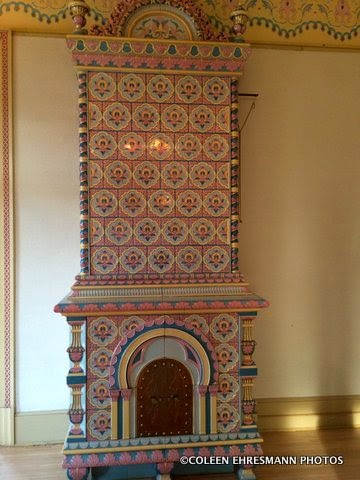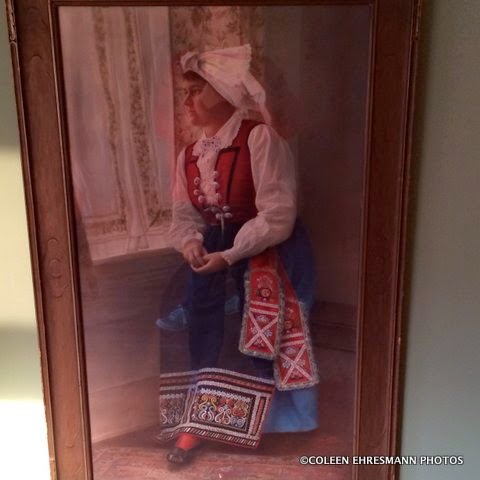



The Turnblad Mansion is the former home of Swan, Christina and Lillian Turnblad.
Sven Johan Oloffsson, Swan, immigrated to Minnesota from Sweden in 1868 at the age of 8. His family were farmers. Swan moved to Minneapolis at the age of 18 and worked as a typesetter at a Swedish newspaper.
Christina Nilsson immigrated to Minnesota in 1875. She was a servant when she met Swan. They married in 1883 and had one daughter, Lillian.
Swan worked for the Swedish newspaper for about ten years before he became the sole owner of the Svenska Amerikanska Postern. His brother Magnus, was the editor. Sven/Swan was very interested in new technology in the printing industry. The newspaper had colored illustrations in 1903. The success of the newspaper made him a millionaire. And as was the tradition of that time, he and Christina bought 6 lots to build a mansion to showcase their success and wealth.
Grand Hall

Construction began in 1904 on the 30 room mansion. It was one of 40 mansions along Park Avenue, a stretch known as "the Golden Mile." The mansion was completed in 1908 with the help of 18 artisans and craftsmen.

The two-story mahogany fireplace is the focus of the grand entrance.
Three outside entrances lead to this area.

Carved lions at the foot of the stairway, just two of many
mythical beasts throughout the mansion.
The Grand Hall is 1 of 7 rooms on the first floor.
Dining Room

The sideboard has both concave & convex glass

Details of the dining room chairs

This carving depicts a scene from a Swedish legend Den bergatagna.
Also on the first floor are the music room, the den,
the breakfast room and the kitchen suite,
all of which were open for touring.
Kitchen Suite

This dual-fuel stove was in the largest of the rooms of the kitchen suite.
The suite included a butler's pantry, dry goods storage, food preparation,
and servants' dining room. There was also an ice box
similar to the one in my basement.
Kakelugns

The mansion has 11 tile stoves.




There seemed to be one in every room, including bed chambers
on the third floor.

Music Room

This wool carpet was woven in Europe and is one of
several originals in the mansion.
Den

The original Moorish lamp

Elaborate geometric ceiling design
Second Floor
Solarium

Cooper-roofed sunroom above the
original carriage entrance

Cocktails at the Castle crowd on the lawn
as seen from the Solarium windows.

The second floor rooms include
the Library, the Reading Room, and
3 Bedchambers

The Visby window, hand-blown & enamel-painted,
on the second floor balcony leading to the solarium
Third Floor

When paint was removed from the ceilings in some of the
third floor rooms, painted flowers were uncovered.
They are believed to be painted by the daughter, Lillian
who was 24 when the family moved into the mansion.

A photograph of Lillian in traditional Swedish costume.

A carved lion with a snake in its mouth.
This is a lamp that originally was on the first floor.
The bulb to the lamp is the mouth of the snake.
Notice the built in dresser in the background.
This room was the third floor bedroom.

This doorway was also in the third floor bedroom.
Also on the third floor was a ballroom, a stage,
an art studio (for Lillian), a lobby and a guest room.
Lower Level

Several clocks were on display in the lower level



Rosemaling
The lower level included the smoking room, a billiard room,
cold storage room, laundry and wine cellar.
The rest of the Turnblad story:
During the 29 years the Turnblad family lived in the mansion, they also kept an apartment in downtown Minneapolis, where they spent most of their time. Christina Turnblad died in 1929. Swan, and daughter Lillian moved across the street and turned their former home into a museum. Swan Turnblad created the American Swedish Institute, as a place to preserve Swedish customs and culture. Swan died May 17, 1933. Their only child, Lillian Zenobia Turnblad, never married and passed away in October 1943.Today the American Swedish Institute is a vibrant museum and cultural center dedicated to the preservation and study of the historic role Sweden and Americans of Swedish heritage have played in US culture and history.
The next post will feature some of the unique Swedish and Nordic art we saw at the museum and the Turnblad Mansion.
No comments:
Post a Comment
Thanks for your comments!